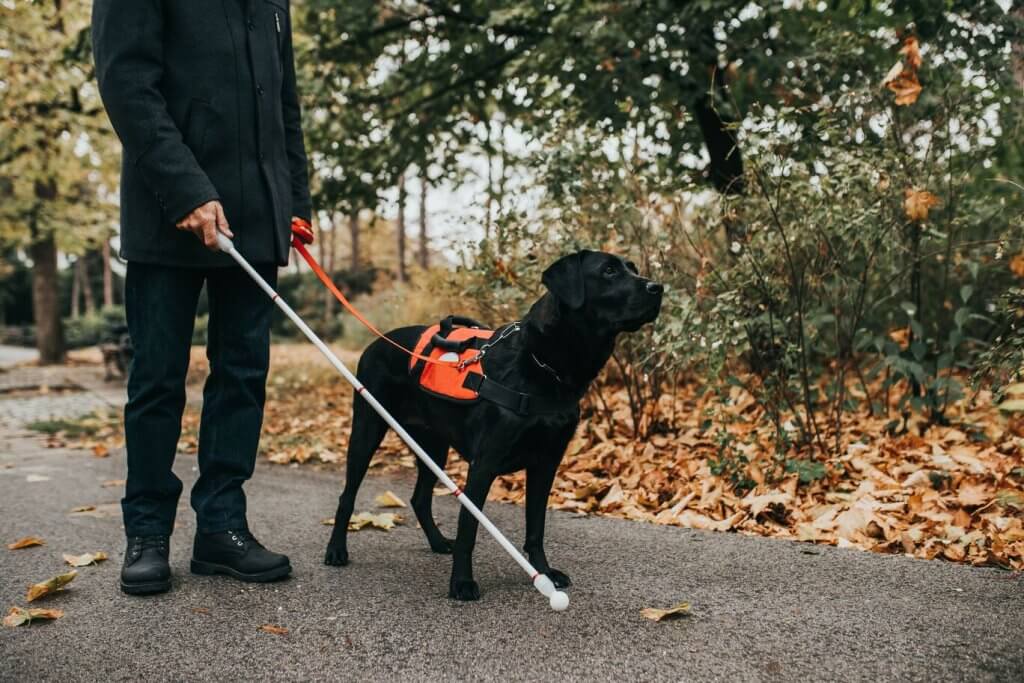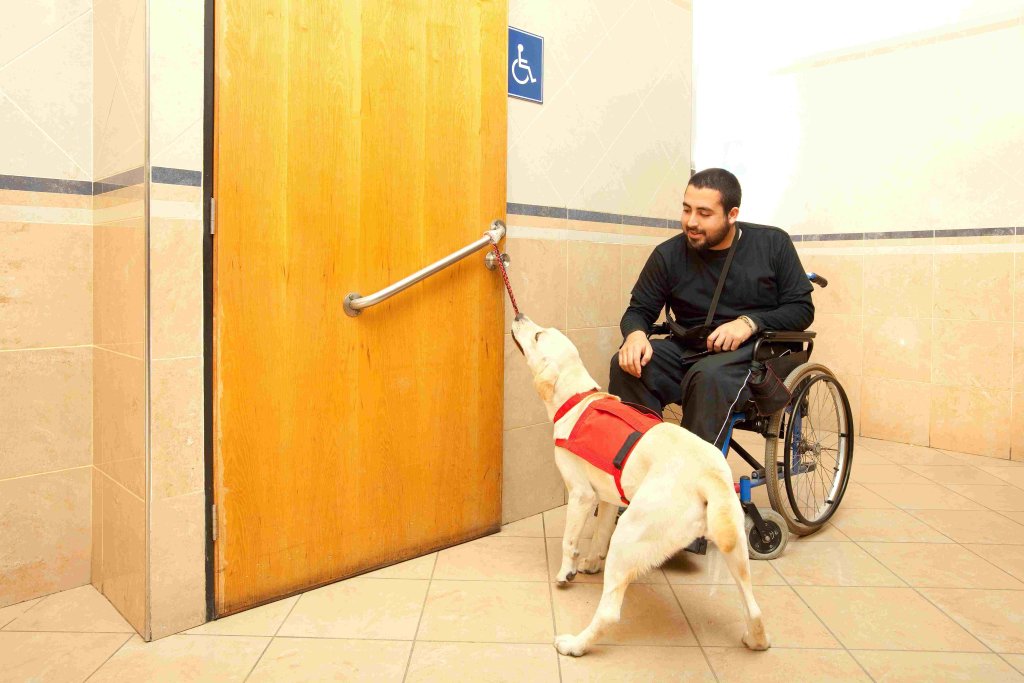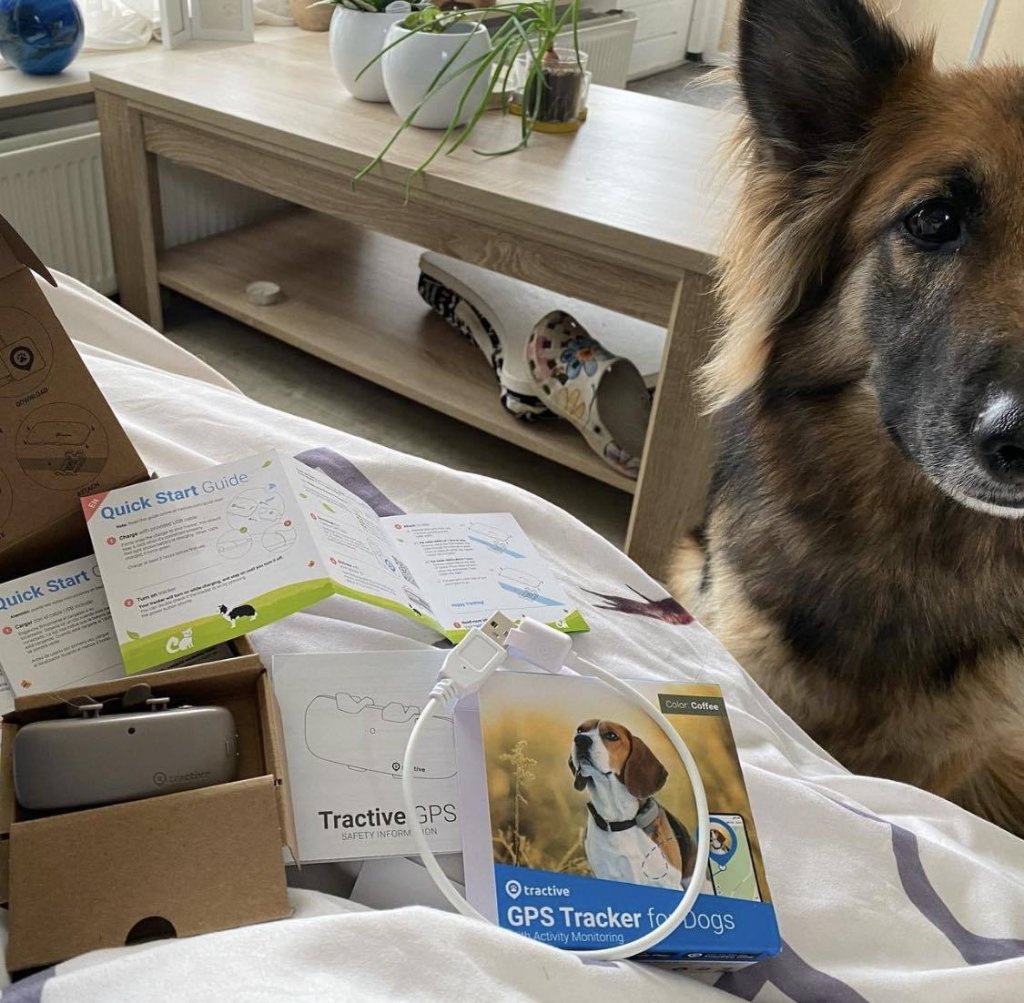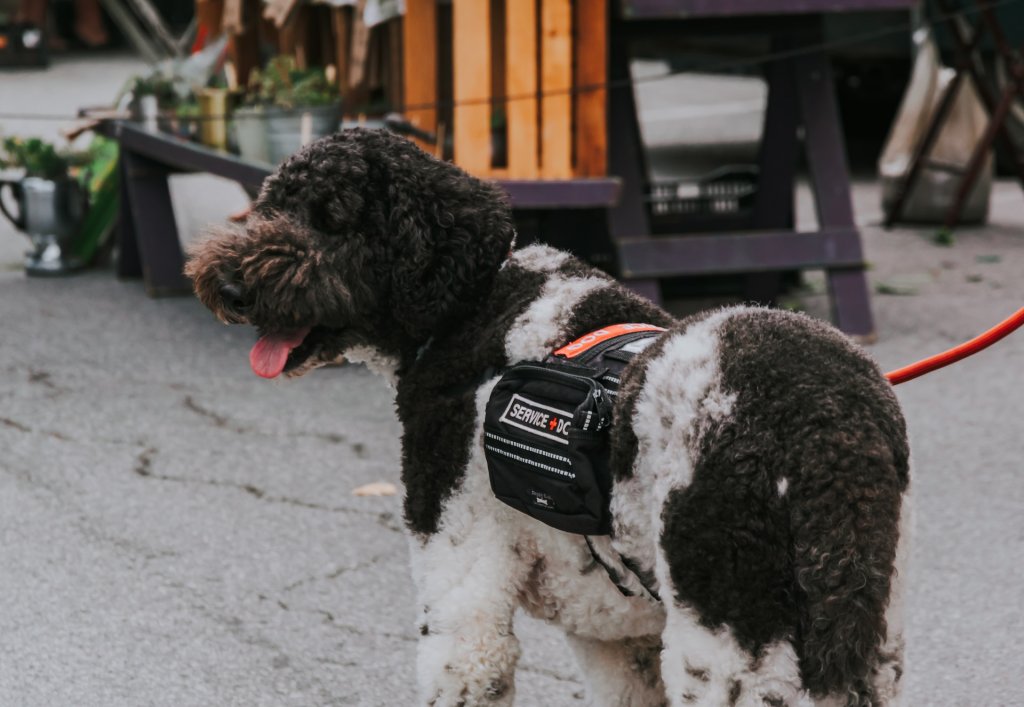Service Dogs & Emotional Support Dogs: What’s The Difference?
What's the difference between service dogs & emotional support dogs? Turns out, they're both two different roles depending on their tasks and training. Here's a deep dive exploring what sets them apart.

There’s a reason we consider dogs our best friends. The roles they play in our lives go far beyond just playing fetch or giving us the good old puppy eyes. And among these roles are two that are often used interchangeably. Aka, service dogs and emotional support dogs. What’s the difference between them? And does it even matter?
While both dogs play important roles in our lives, they both serve distinct functions. So in this article, we’re going to dive into the difference between service dogs and emotional support dogs – and what sets them apart in real life. Let’s get started.
- Service dogs: Trained to support people with disabilities
- How the Tractive GPS helps keep service dogs healthy & safe
- Emotional support dogs: Providing support & companionship
- How to tell the difference between a service dog & an emotional support dog outdoors
- Wrapping up: 4 key differences between service dogs & emotional support dogs
Service dogs: Trained to support people with disabilities
Service dogs are highly-trained dogs who perform certain tasks for people with disabilities. These tasks are directly related to the person’s disability. With the help of a service dog, this helps them be more independent and experience an improved quality of life.

According to the Americans With Disabilities Act (ADA), disabilities can be physical, mental, psychiatric, sensory, or intellectual in nature.1 Importantly, they might limit a person from one or more major life activities, or activities of daily living (ADLs). So you might have seen a service dog:
- Guiding a visually-impaired person across a street (what’s referred to as a seeing eye dog)
- Helping a person using a wheelchair open a door or a cabinet
- Alerting a hard of hearing dog parent to sounds, like a doorbell or someone approaching (or a hearing or signal dog)
- Preventing a person on the autism spectrum from wandering away (or a sensory signal dog)
Besides these, service dogs might also be trained to detect upcoming health conditions.2 These include seizures, epilepsy, or even psychiatric episodes (like with Post-Traumatic Stress Disorder, or PTSD.) In fact, psychiatric service dogs are specifically trained to detect the onset of these disorders So they might remind their parent to take their medication or intervene if they’re about to endanger themselves.
These tasks aren’t just a result of their sensitive, empathetic natures. Rather, service dogs put in a ton of hard work to be classified as such.
How are service dogs trained?
Service dogs go through many hours of training and preparation. Sometimes, it might take them up to 1-2 years to be fully trained.3 In fact, under the ADA, service dogs must be able to complete tasks that help a person with a disability.4 Like, for example, fetching a far-away item from a fridge or switching off a light when instructed.
You could train your own service dog, send your dog to a specialized training program, or be assigned a service dog by a trainer. But importantly, in the US, people with disabilities have the right to train their service dogs by themselves.5 They’re not obliged to send their dog for training at a professional program to assist with their ADLs.

Besides training for disability-specific tasks, service dogs are also trained to bond with their parents. This helps them learn what their parents’ baseline emotional and physiological responses are – so they can take action when needed. This is why experts recommend you be involved at each stage of a service dog’s training.6
What kind of tests do service dogs go through?
Many service dogs go through a public access test.7 This is a test for how a dog might behave in non-pet environments, like restaurants or public transport. In these situations, service dogs must be attuned to their parent at all times and not be easily distracted by the sights, sounds, and smells around them.
Besides these, service dogs also undergo basic obedience training, which includes following commands like:
- Sit
- Heel
- Look at me
- Down
- Leave it
One great way to get started with dog training in general is clicker training. It’s a fun, practical way to train your dog via positive reinforcement. Plus, clicker training works for dogs of all ages, abilities, and temperaments. It’s especially useful for training service dogs to not pull on parents’ leashes, bark, or misbehave in public places.8
How service dogs are protected under US law
Under the US Americans with Disabilities Act (ADA), service dogs are considered as such because of their intense training.9 Aka, when they’re individually trained to perform tasks directly related to a person’s disability. As a result, they’re considered a disability accommodation. Because of this, businesses can’t charge extra or refuse entry when a person with a disability comes accompanied with a service dog.

So because of these legal protections, service dogs have access to places where pets might otherwise be restricted.10 For example, you can bring your service dog into a restaurant, library, public transport, and even some airplanes. However, it’s important that they’re well-trained and on their best behavior in non-pet public places.
Do service dogs need to be certified?
No, under the ADA, it’s not necessary to register a service dog as such.11 However, if they are registered and certified by a reputable national organization, it can help signal that they’re at work supporting their parent with their disability.12 With a service dog ID card or harness, it can help differentiate them from a regular pet. However, these aren’t mandatory.
Should you pet a service dog if you see one in public?
No – it’s best to give service dogs some space if you see one in public. They’re keenly attuned to the needs of their parent, even in distracting or stressful environments. This is why it’s better not to pet or approach a service dog if you see one outdoors. They’re hard at work taking care of their parent and attentively meeting their needs.13
How the Tractive GPS helps keep service dogs healthy & safe
Tractive’s Wellness Monitoring makes it an indispensable tool for monitoring service dog’s health. It offers activity and sleep tracking, which can help pet parents adjust their training as necessary.
Here’s what a Netherlands-based Tractive pet parent shared:
I’ve chosen Tractive to have an extra layer of monitoring for my service dogs (ADL & PTSD). I keep track of them daily because their health is important to me. They can only keep me healthy and happy and do their job if they’re happy and healthy! So it’s a great way to monitor activity and to know when you can train more intensely and when they might need a rest.

What’s more, the Tractive GPS can help you identify and intervene early on in case of a health issue. For example, a sudden dip in your dog’s regular activity – or a change in their sleep patterns – can indicate that something is wrong. So you can take action and get them to a vet right away – which might even save your dog’s life.

Evi, the PTSD dog was the first to try it out. And after three and a half weeks of using, and finally really trusting the data that Tractive gave me, I found out she was sick before I could even really see it. Her sleep quality suddenly drastically decreased from around 90% to 60% and her active minutes dropped by about 50 a day.
So even though she still looked happy and healthy, my Tractive device stated otherwise. So I went to the vet with this information. They took me and Tractive seriously…and it turned out she had the beginning of an infection in her ears!My Tractive GPS is a part of my primary gear now – and I don’t want it any other way.
Emotional support dogs: Providing support & companionship
Emotional support dogs provide comfort and companionship to people experiencing mental health difficulties.14 In fact, any animal could be considered an emotional support animal (ESA) – not just dogs. Their role is to provide a loving, non-judgmental, supportive presence when their parent is experiencing mental health difficulties.
Are emotional support dogs service dogs?
No. In fact, tasks and training are the main difference between service dogs and emotional support dogs. Emotional support dogs don’t need any formal training to help improve one’s mental health. They’re not trained to carry out activities of daily living (ADLs) or specific tasks to help someone live more independently. In fact, they’re considered on the same level as pets.

As a result, emotional support dogs don’t have the same legal status as service dogs. But under US law, a health professional can prescribe an emotional support animal (ESA) to a single person as a part of their therapeutic plan.15
What do emotional support dogs do?
An emotional support dog can offer you comfort and a sense of acceptance and security when you’re experiencing emotional or psychological difficulties. (Like, for example, cuddling close to you when you’re crying.) When they’re near, it can potentially reduce feelings of anxiety, depression, and even some traumas.16 Much like therapy dogs, emotional support dogs can help people feel more relaxed and accepted with their supportive, non-judgmental presence.
But are emotional support dogs the same as therapy dogs? No. Both dogs might do similar work – i.e. providing companionship and comfort. But emotional support dogs primarily support one person experiencing mental health difficulties. Therapy dogs, on the other hand, work with groups of people in care environments like hospitals, facilities, crisis zones, and even schools.
Emotional support dogs are primarily intended to support you through your mental and emotional difficulties. Some mental health professionals might prescribe them as part of a therapeutic treatment plan. But they might not be the best choice for people with physical, developmental, or cognitive disabilities, since they lack the necessary training.
Are emotional support dogs legally protected like service dogs?
Emotional support dogs aren’t protected legally the way service dogs are under the ADA. The ADA even states that animals that simply provide emotional comfort don’t qualify as service animals. Emotional support dogs might be able to accompany a parent to most housing and transportation services, who might make accommodations. They’re also protected under the US Fair Housing Act, which lets them stay with their parents.21 But their access to other public places (like, say, cafes or museums) might be limited.

Importantly, emotional support dogs aren’t the same as psychiatric service dogs.22 The difference lies in their training and tasks these dogs perform. Under the ADA, if the dog is simply offering a comforting presence when their parent is experiencing mental health difficulties, they don’t qualify as a psychiatric service dog.
How can a dog be registered as an emotional support animal (ESA)?
In order to be considered an emotional support animal (ESA), these dogs should be prescribed as part of a mental health treatment plan by a professional.23 The patient in question also needs to be experiencing a disabling mental illness that’s recognized under federal law. Along with this, a team of mental health professionals usually need to determine that the presence of an animal is vital to the treatment of the patient.
Certifying an emotional support dog as an ESA can help qualify people to be accompanied in places where pets might not be allowed (like when renting a flat). For this, you’d need an ESA letter issued by a qualified mental health professional, stating why the presence of an emotional support dog is necessary. Different public services (like airlines) might have different requirements – so make sure to check those in advance.
How to tell the difference between a service dog & an emotional support dog outdoors
Now that you know the difference between service dogs and emotional support dogs and their work, here are a couple of ways you can tell when out in public:
Vesting & identification
You might see a service dog wearing an identifiable vest or a harness indicating their role and what task they might be supporting. While this isn’t mandatory, it can help define their role and indicate that they’re hard at work and shouldn’t be disturbed. Emotional support dogs, on the other hand, might not wear any identifiable gear or ID. Rather, they’re more or less on the same level as pets.

Access rights
You might see a vested service dog quietly sitting at the feet of your airplane passenger neighbor – and they’re fully within their rights to do so. That’s because of their public access rights under the ADA, which can be quite far-reaching. On the other hand, emotional support dogs might not be allowed in all public places. An ESA letter can help in certain cases, but not necessarily everywhere.
Certification & registration
While not legally required, service dogs might go through official certification and registration procedures. This is to ensure that they can freely access public spaces, especially areas where staff might request an ID or other proof that they’re actually a service dog.
Emotional support dogs can be certified with an Emotional Support Animal (ESA) Certificate. In order to get one, you will need an ESA letter from a mental health professional confirming that you’ve been prescribed an emotional support dog and that their presence is part of your treatment plan. Make sure to obtain your ESA certificate from a reputable source including a full psychiatric evaluation.
Wrapping up: 4 key differences between service dogs & emotional support dogs
Here’s a quick distinction between service and emotional support dogs and how they differ in their roles and other factors:
| Service dogs | Emotional support dogs | |
| Training | Intensive, required | Basic, not required |
| Tasks | Completing tasks for people with disabilities | Providing emotional comfort and companionship to people with mental health difficulties |
| Access | Full public access | Limited public access |
| Legal protection | Fully protected under the Americans With Disabilities Act (ADA) | Not protected under the ADA, but included within the Fair Housing Act |
Now that you’re informed about the difference between the two, you can better understand the legal rights and responsibilities associated with each type of dog. In both cases, it makes sense to get in touch with a healthcare professional and legal experts who can help you make an informed decision.
When it comes to the different roles that dogs play, you might still come across a bunch of myths and misconceptions. So here are 5 myths about service dogs and emotional support dogs debunked by My ESA Doctor:




